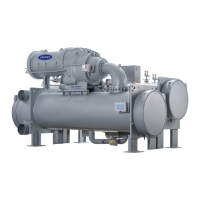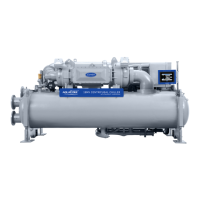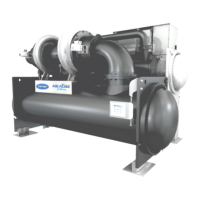32
required for all modulating analog actuators. Upon successful
calibration go Main Menu → Quick Test and verify operation on
desired components. Note that this is a very useful feature for
troubleshooting. (The QUICK TEST screens can only be
accessed when the chiller is in STOP mode.) On the QUICK
TEST table screen, select a test to be performed.
The Quick Test checks all outputs and inputs for proper
functionality. In order to successfully proceed with the controls
test, the compressor must be off, no alarms showing, and volt-
age should be within ±10% of rating plate value. Each test asks
the operator to confirm the operation is occurring and whether
or not to continue. If an error occurs, the operator can try to ad-
dress the problem as the test is being done or note the problem
and proceed to the next test.
NOTE: The refrigerant pump test will not energize the pump if
cooler pressure is below –13 psig (–90 kPa).
When the controls test is finished the test stops and the
QUICK TEST menu displays. If a specific automated test pro-
cedure is not completed, access the particular control test to test
the function when ready. Disable the Quick Test feature when
testing is complete. For information about calibration, see the
sections Checking Pressure Transducers, page 49, and High Al-
titude Locations, page 50.
COOLER AND CONDENSER PRESSURE TRANS-
DUCER AND WATERSIDE FLOW DEVICE CALIBRA-
TION (Waterside Device Optional with IOB Inputs
Available) — Calibration can be checked by comparing the
pressure readings from the transducer to an accurate refrigera-
tion gage reading. The transducer can be checked and calibrated
at 2 pressure points. These calibration points are 0 psig (0 kPa)
and between 10 psig (68.9 kPa) - 30 psig (206.8 kPa). To cali-
brate these transducers:
1. Shut down the compressor and the cooler and condenser
pumps.
NOTE: There should be no flow through the heat
exchangers.
2. Disconnect the transducer in question from its Schrader
fitting for cooler or condenser transducer calibration. For
pump pressure or bearing pressure or flow device calibra-
tion keep transducer in place.
NOTE: If the cooler or condenser vessels are at 0 psig
(0 kPa) atmospheric pressure, the transducers can be
calibrated for zero without removing the transducer
from the vessel.
3. Access the PRESSURE screen from the Main Menu and
view the particular transducer reading (the cooler pres-
sure, condenser pressure, economizer pressure, pump in-
let pressure, pump outlet pressure, bearing inlet pressure,
bearing outlet pressure).
To calibrate a device, view the particular reading on the
screen. It should read 0 kPa). If the reading is not 0 kPa,
but within 35 kPa, the value may be set to zero while the
appropriate transducer parameter is highlighted. The val-
ue will now go to zero. No high end calibration is neces-
sary for REF PUMP DELTA P or flow devices. If the
transducer value is not within the calibration range, the
transducer will return to the original reading. If the pres-
sure is within the allowed range (noted above), check the
voltage ratio of the transducer. To obtain the voltage ratio,
divide the voltage (dc) input from the transducer by the
supply voltage signal (See Maintenance Others in Main-
tenance Menu) or measure across the positive (+ red) and
negative (– black) leads of the transducer. The voltage ra-
tio must be between 0.80 and 0.11 for the software to al-
low calibration. Rotate the waterside flow pressure device
from the inlet nozzle to the outlet nozzle and repeat this
step. If rotating the waterside flow device does not allow
calibration then pressurize the transducer until the ratio is
within range. Then attempt calibration again.
4. A high pressure point can be calibrated between 10-30
psig (68.9 -206.8 kPa) by attaching a regulated pressure
source (usually from a nitrogen cylinder with high resolu-
tion pressure gage). The high pressure point can be cali-
brated by accessing the appropriate transducer parameter
on the PRESSURES screen, highlighting the parameter,
then increasing or decreasing the value to the exact pres-
sure on the refrigerant gage.
Pressures at high altitude locations must be compensated for,
so the chiller temperature/pressure relationship is correct. This
is set in the Service Parameters (Configuration Menu).
The PIC5 does not allow calibration if the transducer is too
far out of calibration. In this case, a new transducer must be in-
stalled and re-calibrated.
OPTIONAL THERMAL DISPERSION FLOW SWITCH
CALIBRATION — Set the flow through the water circuit to
the minimum safe flow that will be encountered.
Reduce the sensitivity of the switch by turning the adjust-
ment counter-clockwise until the yellow LED turns off. This in-
dicates that the switch is now open.
Increase the sensitivity of the flow switch by turning the ad-
justment potentiometer clockwise until the yellow LED is lit.
In case of nuisance trips at low flow increase the sensitivity
of the switch by turning the potentiometer clockwise.
HYDRAULIC STATUS — The HYDRAULIC STATUS
screen (access from the Main Menu) provides a convenient
way to detect if any of the cooler/condenser pressure
switches (if installed) are in need of calibration. See Fig. 29
for the hydraulic status menu. With no flow the water delta
should read 0 kPa. If it does not, the value may be set to
zero using PRESSURE SENSOR CALIB located in the
Maintenance Menu. See Fig. 30 for the pressure sensor cali-
bration menu. High end calibration is not necessary.
Fig. 29 — Hydraulic Status Menu
IMPORTANT: When screen display calibration is com-
plete, do not depress calibration Enable/Dsable since
the new values will be deleted. Values are kept by exit-
ing the pressure sensor table.
IMPORTANT: When screen display calibration is com-
plete, do not depress calibration Enable/Dsable since
the new values will be deleted. Values are kept by exit-
ing the pressure sensor table.

